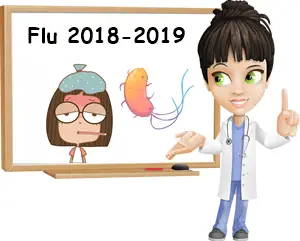Start of October 2018, the flu season has officially arrived in the northern hemisphere and is expected to last until at least April 2019. That’s 5 to 6 months, enough time for many of use to catch the pesky virus. Which begs the question: is there something new you should know about the flu this season? And what are the key points to take with you as far as prevention, management and recovery from the respiratory infection are concerned? Find out all the information you need to best get through 6 months of flu in this useful guide below.
When does the 2018-2019 flu season start and how long does it last?
This year’s flu season starts in early October and is expected to last up until late April in the northern hemisphere. December 2018 throughout February 2019 is likely to be the busiest time of all flu season as infection rates typically reach a season high. Conversely, the southern hemisphere flu season starts in April 2019 and lasts until September 2019, with infection rates peaking about 2 months into the season. Of course, it’s possible to catch the flu outside the ‘official’ season timeline, whether it’s one of this year’s virus strains or not.

The 3 major influenza viruses that cause infection and disease in humans are: influenza A, influenza B and influenza C. Of all three, A and B are the most contagious. They are the most likely to occur in different variants every flu season and are the root of widespread epidemics. As such, most vaccines contain either 2 influenza A virus strains and 1 influenza B strain or 2 influenza A virus strains and 2 influenza B strains. The choice for vaccines composition is made based on the most common circulating viruses.
What viruses do you need to watch out for this season and can expect to find in this year’s vaccines?
According to the World Health Organization (WHO), the 2018-2019 flu season’s most common circulating virus strains in the northern hemisphere and recommended vaccines include the following:
1) A/Michigan/45/2015 (H1N1)pdm09-like virus
Influenza A virus originating in Michigan 2015
2) A/Singapore/INFIMH-16-0019/2016 A(H3N2)-like virus
Influenza A virus originating in Singapore in 2016
3) B/Colorado/06/2017-like virus (B/Victoria/2/87 lineage)
Influenza B virus originating in Victoria (Australia), 2017
4) B/Phuket/3073/2013-like virus (B/Yamagata/16/88 lineage)
Influenza B virus originating in Phucket (Thailand), 2013
The 2018 southern hemisphere flu season circulating virus strains (also covered by vaccines) were:
1) A/Michigan/45/2015 (H1N1)pdm09-like virus
2) A/Singapore/INFIMH-16-0019/2016 (H3N2)-like virus
3) B/Phuket/3073/2013-like virus
4) B/Brisbane/60/2008-like virus
For the 2019 southern hemisphere flu season, vaccines cover the following influenza strains:
1) A/Michigan/45/2015 (H1N1)pdm09-like virus
2) A/Switzerland/8060/2017 (H3N2)-like virus
3) B/Colorado/06/2017-like virus (B/Victoria/2/87 lineage)
4) B/Phuket/3073/2013-like virus (B/Yamagata/16/88 lineage)

What symptoms should you watch out for?
For the most part, flu symptoms include runny or stuffy nose, sore throat, high fever, often alternating with chills and shivering, generalized muscle aches and joint pain, weakness, fatigue and feelings of unwell. As the infection advances, it may progress to cough, loss of appetite, chest discomfort, gastrointestinal upset (nausea, vomiting) and even fainting (see Flu and Fainting). Headaches, earaches, light sensitivity are also common.
It’s important to note that not everyone experiences the same symptoms or symptoms of the same severity. Actually, roughly a third of those with the flu are asymptomatic. Symptoms duration is also variable (on average, from 2-4 days to 2 weeks).
When should you see a doctor?
If you have a high fever that doesn’t break (is too high or lasts more than 2-4 days), cannot drink or eat, cannot keep fluids or food down (because of vomiting and diarrhea), experience severe chest discomfort, wheezing, shortness of breath or any form of difficult breathing, brain fog (mental confusion), then seek medical help. Also, see a doctor if you recover from the flu, then your condition deteriorates.
Who is the most likely to experience complications from the flu?
The flu is something a strong and healthy host can fight and build immunity against, despite the continual evolution of the causative agent. However, children (whose immune system is not fully developed or as strong as that of an adult) and anyone with a chronic medical condition (heart disease, diabetes, cancer) or immunodeficiency are at risk for complications and are best monitored by a medical professional in case of a respiratory infection.
Health authorities recommend getting vaccinated, preferably 2-3 weeks before the ‘official’ start of the flu season (early October). This is because it takes around 2 weeks for our immune system to map out the virus strains contained in a vaccine and produce antibodies against them. However, health authorities claim there are benefits to vaccination throughout the flu season for those who have not contracted the respiratory infection up to that point. Said benefits include less severe symptoms and speedier recovery time in case of a subsequent respiratory infection as well as reduced risk of complications.
If you have caught the flu already, then you will have likely built immunity against the respective strain(s) naturally. Of course, there are multiple circulating influenza strains each flu season (the most common of which vaccines typically cover) so you may develop another or multiple respiratory infections up until the end of the season. Whether you opt for or out of vaccination at this point is something best discussed with your doctor. Whatever your choice, remember that a speedy recovery requires you to take good care of yourself, rest, eat, stay hydrated and continue to practice good hygiene.
